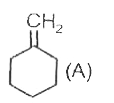In the reaction with HCl, an alkene reacts in accordance with Markownikoff's rule to give a product 1-chloro-1-methylcyclohexane. The possible alkene is:


(A) and (B)

The correct Answer is:3
To solve the problem, we need to identify the alkene that reacts with HCl to produce 1-chloro-1-methylcyclohexane according to Markovnikov's rule. Let's break down the steps:
Step 1: Understand Markovnikov's Rule
Markovnikov's rule states that when HX (where X is a halogen) is added to an alkene, the hydrogen atom (H) will attach to the carbon with the greater number of hydrogen atoms, while the halogen (X) will attach to the carbon with fewer hydrogen atoms. This leads to the formation of the more stable carbocation intermediate.
Step 2: Analyze the Product
The product we are looking for is 1-chloro-1-methylcyclohexane. This indicates that:
- The chlorine atom is attached to the first carbon of the cyclohexane ring.
- A methyl group is also attached to the same carbon (C1).
Step 3: Identify Possible Alkenes
We need to consider alkenes that could lead to this product upon reaction with HCl. The alkene should have a double bond that allows for the formation of a stable carbocation.
Step 4: Evaluate Each Option
1. Option A: Check the structure of the alkene. When HCl reacts, H will add to the carbon with more hydrogens, leading to a stable carbocation. The chlorine will then attach to the carbon with fewer hydrogens.
2. Option B: Similar to option A, analyze the structure. Determine where H will add and where the carbocation will form. If it leads to the desired product, it is a valid option.
3. Option C: Check if the structure can lead to the formation of the desired product. Consider the stability of the carbocation formed and whether the chlorine will attach to the correct carbon.
4. Option D: If applicable, analyze this option as well.
Step 5: Conclusion
After evaluating the options, we find that both option A and option B lead to the formation of 1-chloro-1-methylcyclohexane. Therefore, the possible alkene(s) that can react with HCl to yield the desired product are found in these options.
Final Answer
The possible alkene is Option A and Option B.
---
Markovnikov's rule states that when HX (where X is a halogen) is added to an alkene, the hydrogen atom (H) will attach to the carbon with the greater number of hydrogen atoms, while the halogen (X) will attach to the carbon with fewer hydrogen atoms. This leads to the formation of the more stable carbocation intermediate.
The product we are looking for is 1-chloro-1-methylcyclohexane. This indicates that:
- The chlorine atom is attached to the first carbon of the cyclohexane ring.
- A methyl group is also attached to the same carbon (C1).
We need to consider alkenes that could lead to this product upon reaction with HCl. The alkene should have a double bond that allows for the formation of a stable carbocation.
1. Option A: Check the structure of the alkene. When HCl reacts, H will add to the carbon with more hydrogens, leading to a stable carbocation. The chlorine will then attach to the carbon with fewer hydrogens.
2. Option B: Similar to option A, analyze the structure. Determine where H will add and where the carbocation will form. If it leads to the desired product, it is a valid option.
After evaluating the options, we find that both option A and option B lead to the formation of 1-chloro-1-methylcyclohexane. Therefore, the possible alkene(s) that can react with HCl to yield the desired product are found in these options.
The possible alkene is Option A and Option B.
Topper's Solved these Questions
- HYDROCARBONSBOOK - AAKASH INSTITUTE ENGLISHCHAPTER - HYDROCARBONSEXERCISE - Assignment(Section - B) (Obejctive type question)
5 Videos
- HALOALKANES AND HALOARENES BOOK - AAKASH INSTITUTE ENGLISHCHAPTER - HALOALKANES AND HALOARENES EXERCISE - ASSIGNMENT SECTION -D
15 Videos
- HYDROGENBOOK - AAKASH INSTITUTE ENGLISHCHAPTER - HYDROGENEXERCISE - ASSIGNMENT (SECTION - D) (Assertion-Reason Type question)
15 Videos
Similar Questions
Knowledge Check
An unknown alkene (A) reacts with 3 mole of H2 gas in presence of platinum catalyst to form 1-isopropyl-4-methyl cyclohexane. When unknown alkene (A) is ozonized and reduced, following product are obtained
H−O∣∣C−H H−O∣∣C−CH2−O∣∣−O∣∣C−CH3, CH3−O∣∣C−CH2−O∣∣C−H
The alkene (A) is :A B
B C
C D
D
Which of the following alkenes will give anti-markownikoff's product as major product.
View Solutionwhich alkene does not follow Anti-Markownikoff's addition rule
View SolutionThe reaction of vinyl chloride with hydrogen iodide to give 1-chloro-1-iodoethane is an example of anti-Markownikoff's rule.
View SolutionConsider the following reaction.
_S01_372_Q01.png)
(1R,3S)-cis-Bromo-3-methylcyclohexane
The product formed in the reaction is
View SolutionIn the presence of peroxide addition of HBr to propene takes place according to anti Markownikoff's rule but peroxide effect is not seen in the case of HCl and HI. Explain.
View SolutionName of the alkene which will yield 1-chloro-1-methylcyclohexane by its reaction with HCl. Write the reaction involved.
View SolutionWhich alkene upon reductive ozonolysis will give acetone as the product?
View Solution
